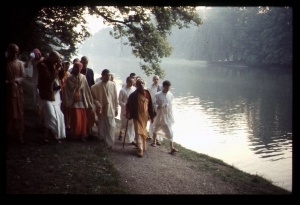SB 4.29.9: Difference between revisions
m (1 revision(s)) |
(Vanibot #0018 edit: make synonym terms in Sanskrit italic in SB - Vanisource) |
||
| Line 1: | Line 1: | ||
{{info | {{info | ||
|speaker= | |speaker=Nārada Muni | ||
|listener=King | |listener=King Prācīnabarhiṣat | ||
}} | }} | ||
[[Category:Srimad-Bhagavatam - Canto 04 Chapter 29|s09 ]] | |||
[[Category:Bhagavatam Verses Spoken by Narada Muni - Vanisource|042909]] | |||
<div style="float:left">'''[[Srimad-Bhagavatam]] - [[SB 4|Fourth Canto]] - [[SB 4.29: Talks Between Narada and King Pracinabarhi|Chapter 29: Talks Between Nārada and King Prācīnabarhi]]'''</div> | |||
<div style="float:right">[[File:Go-previous.png|link=SB 4.29.8]] '''[[SB 4.29.8]] - [[SB 4.29.10]]''' [[File:Go-next.png|link=SB 4.29.10]]</div> | |||
{{RandomImage}} | |||
==== TEXT 9 ==== | ==== TEXT 9 ==== | ||
<div | <div class="verse"> | ||
akṣiṇī nāsike āsyam | :akṣiṇī nāsike āsyam | ||
iti pañca puraḥ kṛtāḥ | :iti pañca puraḥ kṛtāḥ | ||
dakṣiṇā dakṣiṇaḥ karṇa | :dakṣiṇā dakṣiṇaḥ karṇa | ||
uttarā cottaraḥ smṛtaḥ | :uttarā cottaraḥ smṛtaḥ | ||
paścime ity adho dvārau | :paścime ity adho dvārau | ||
gudaṁ śiśnam ihocyate | :gudaṁ śiśnam ihocyate | ||
</div> | </div> | ||
| Line 18: | Line 24: | ||
==== SYNONYMS ==== | ==== SYNONYMS ==== | ||
<div | <div class="synonyms"> | ||
''akṣiṇī''—two eyes; ''nāsike''—two nostrils; ''āsyam''—the mouth; ''iti''—thus; ''pañca''—five; ''puraḥ''—on the front; ''kṛtāḥ''—made; ''dakṣiṇā''—southern gate; ''dakṣiṇaḥ''—right; ''karṇaḥ''—ear; ''uttarā''—northern gate; ''ca''—also; ''uttaraḥ''—left ear; ''smṛtaḥ''—understood; ''paścime''—on the west; ''iti''—thus; ''adhaḥ''—downward; ''dvārau''—two gates; ''gudam''—rectum; ''śiśnam''—genital; ''iha''—here; ''ucyate''—is said. | |||
</div> | </div> | ||
| Line 25: | Line 31: | ||
==== TRANSLATION ==== | ==== TRANSLATION ==== | ||
<div | <div class="translation"> | ||
Two eyes, two nostrils and a mouth—all together five—are situated in the front. The right ear is accepted as the southern gate, and the left ear is the northern gate. The two holes, or gates, situated in the west are known as the rectum and genital. | Two eyes, two nostrils and a mouth—all together five—are situated in the front. The right ear is accepted as the southern gate, and the left ear is the northern gate. The two holes, or gates, situated in the west are known as the rectum and genital. | ||
</div> | </div> | ||
| Line 32: | Line 38: | ||
==== PURPORT ==== | ==== PURPORT ==== | ||
<div | <div class="purport"> | ||
Of all sides, the eastern is considered most important, primarily because the sun rises from that direction. The gates on the eastern side—the eyes, nose and mouth—are thus very important gates in the body. | Of all sides, the eastern is considered most important, primarily because the sun rises from that direction. The gates on the eastern side—the eyes, nose and mouth—are thus very important gates in the body. | ||
</div> | </div> | ||
__NOTOC__ | |||
<div style="float:right; clear:both;">[[File:Go-previous.png|link=SB 4.29.8]] '''[[SB 4.29.8]] - [[SB 4.29.10]]''' [[File:Go-next.png|link=SB 4.29.10]]</div> | |||
__NOTOC__ | |||
__NOEDITSECTION__ | |||
Revision as of 23:55, 30 November 2017

A.C. Bhaktivedanta Swami Prabhupada
TEXT 9
- akṣiṇī nāsike āsyam
- iti pañca puraḥ kṛtāḥ
- dakṣiṇā dakṣiṇaḥ karṇa
- uttarā cottaraḥ smṛtaḥ
- paścime ity adho dvārau
- gudaṁ śiśnam ihocyate
SYNONYMS
akṣiṇī—two eyes; nāsike—two nostrils; āsyam—the mouth; iti—thus; pañca—five; puraḥ—on the front; kṛtāḥ—made; dakṣiṇā—southern gate; dakṣiṇaḥ—right; karṇaḥ—ear; uttarā—northern gate; ca—also; uttaraḥ—left ear; smṛtaḥ—understood; paścime—on the west; iti—thus; adhaḥ—downward; dvārau—two gates; gudam—rectum; śiśnam—genital; iha—here; ucyate—is said.
TRANSLATION
Two eyes, two nostrils and a mouth—all together five—are situated in the front. The right ear is accepted as the southern gate, and the left ear is the northern gate. The two holes, or gates, situated in the west are known as the rectum and genital.
PURPORT
Of all sides, the eastern is considered most important, primarily because the sun rises from that direction. The gates on the eastern side—the eyes, nose and mouth—are thus very important gates in the body.